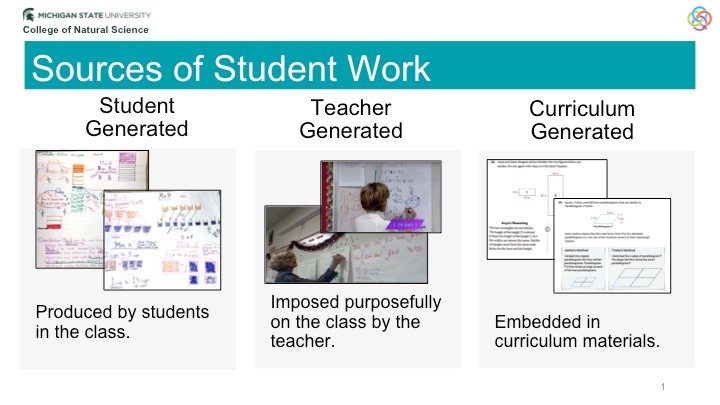The Student Work in Curriculum Materials Research Project
Project Start Date: March, 2012
Project Team: Elizabeth Phillips, AJ Edson, Yvonne Grant, Nic Gilbertson, Aladar Horvath, Eun Mi Kim, Kevin Lawrence, Jen Nimtz, Joanne Philhower, & Amy Ray
Background
In Connected Mathematics, student work as a context for student leaning is central to the success of CMP. As shown in the figure, we differentiate between curriculum-generated student work, from teacher generated student work and student generated student work because examples of student work in curriculum materials are uniquely positioned as external to the classroom interaction. For this reason, it may provide opportunities for engagement and discussion that is qualitatively different from the other two types of student work.

Curriculum generated student work is featured implicitly throughout the CMP curriculum as a context for learning. Examples of student work in the curriculum materials are found in mathematical tasks that refer to thinking or strategies that are attributed to a character (or person in the situation). For example, the thinking or strategies might include written mathematical claims, student conjectures, reasoning, observations, algorithms, or reflections. The examples of student work also include a question or prompt for the reader to explore. These might include analyzing, critiquing, or reflecting on the mathematical thinking/actions of the character in the text.
Description
Examples of student work in the student editions and teacher support help enhance students’ conceptual understanding, refine their competence with mathematical procedures, and broaden their capacity to make sense of situations. For instance, curricular tasks with student work may provide an opportunity for students to practice critiquing another’s reasoning because the emphasis can be on the idea not a person. Likewise, teachers might benefit from curricular examples of student work because it may provide representations of ways that students could communicate in their classroom such as looking across strategies to determine the most reasonable approach. Thus, examples of student work in curriculum materials could serve as a productive site for improving student-teacher interactions, as well as developing deeper and more meaningful understanding of content. For a description of the types and location of student work in the CMP curriculum see Role of Student Work in Promoting Understanding and Reasoning.
Purpose
The potential benefits of curricular examples of student work are largely unknown because most research related to student work has examined effects of student work for enhancing student learning and teachers’ mathematical knowledge for teaching. The purpose of this project is to explore the use of student work found in curriculum materials and its potential for improving the teaching-learning environment.